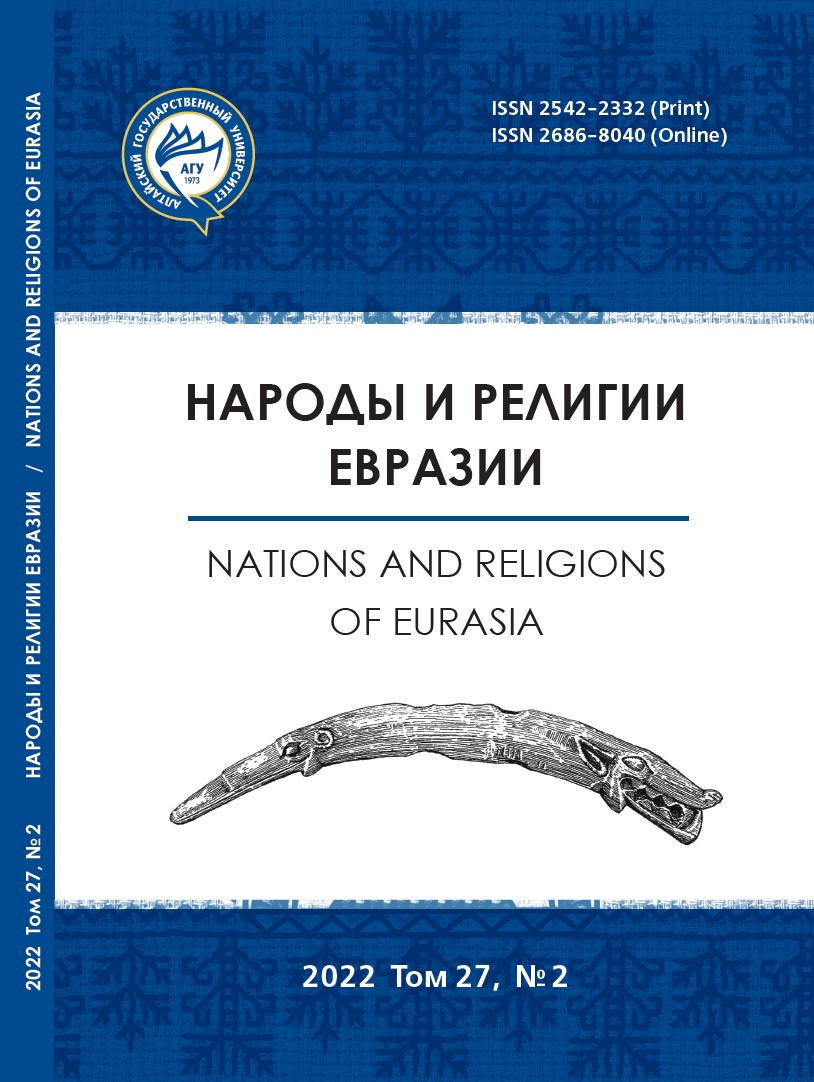A term qut in the monuments of old turkic runic writing revisited
Main Article Content
Abstract
The article proposed is devoted to the revision of the view on related to the interpretation of the word qut in the monuments of Old Turkic runic writing as a kind of substance that given to the nomadic ruler by the Heaven (divine charisma) and associated with the concept of supreme power. The paper examines the fragments contained the word qut in Old Turkic monuments to show that it's such interpretation prevailing in the scientific tradition can be acceptable for selected contexts, but unreasonable in general. The author of the article proposes to interpret them without a dependence imposed by theories. It is possible to analyze same contexts based on the ethnographic data. As a result, it looks quite adequate the understanding of qut in the monuments of Old Turkic runic writing as "vital force" or a kind of "vital energy", maybe "health indicator", that is a characteristic which all living things possess. It should not at all affect the interpretation of the word analyzed the use of it both in the same context with mentions of Tanri ('Heaven') and in combinations with the word qaghan. At least, following the contexts of the monuments in general, a qaghan, with the exception of his functions implied by his position, is otherwise no different from other representatives of the societies of Early Turks.
Downloads
Metrics
Article Details

This work is licensed under a Creative Commons Attribution 4.0 International License.
References
Древнетюркский словарь. Л. : Наука, 1969. XXXVIII, 714 с.
Зуев Ю. А. Ранние тюрки: очерки истории и идеологии. Алматы : Дайк-Пресс, 2002. 338 с.
Кляшторный С. Г. История Центральной Азии и памятники рунического письма. СПб. : Филологический факультет СПбГУ, 2003. 560 с.
Кононов А. Н. Грамматика языка тюркских рунических памятников VII-IX вв. Л. : Наука, 1980. 170 с.
Потапов Л. П. Умай — божество древних тюрков в свете этнографических данных // Тюркологический сборник. 1972. Памяти П. М. Мелиоранского. М. : Наука, 1973. С. 265-286.
Потапов Л. П. Алтайский шаманизм. Л. : Наука, 1991. 320 с.
Рухлядев Д. В. Древнетюркские рунические надписи VIII-IX вв. как памятник историографии: генезис жанра и структура текста : дис. ... канд. ист. наук. СПб., 2005. 270 с.
Сравнительно-историческая грамматика тюркских языков. Пратюркский язык-основа. Картина мира пратюркского этноса по данным языка. М. : Наука, 2006. 908 с.
Тишин В. В. Снова о понятии циТ. в памятниках древнетюркской рунической письменности // Восточная Европа в древности и средневековье. Чтения памяти члена-корреспондента АН СССР Владимира Терентьевича Пашуто. Вып. XXХIII: Роль религии в формировании социокультурных практик и представлений. М. : ИВИ РАН, 2021. С. 281-286.
Этимологический словарь тюркских языков: Общетюркские и межтюркские лексические основы на буквы «К» (~«Г») и «К» ~«К»). Выпуск второй. М. : Индрик, 2000. 261 с.
Alimov R. II. Karabalgasun Yaziti // Modern Türklük Arastirmalari Dergisi. 2015. Cilt 12. Sayi 4. S. 27-38.
Aydin E. Hoyto-Tamir (Tayhar-Çuluu) Yazitlari // Türkbilig. 2017. Sayi 33. S. 1-14.
Bombaci A. Quthry bolzun! A Contribution to the concept of "fortune" among the Turks // Ural-Altaische Jahrbücher. 1965. Vol. 36. Fasc. 3-4. S. 284-291; 1966. Vol. 38. S. 13-43.
Clauson G. An Etymological Dictionary of Pre-Thirteenth-Century Turkish. Oxford: Clarendon Press, 1972. XLVIII, 989 p.
Dobrovits M. The Great Western Campaign of the Eastern Turks (711-714) // Acta Orientalia Academiae Scientiarum Hungaricae. 2005. T. 58. Pt. 2. P. 179-185.
Doerfer G. Türkische und mongolische Elemente im Neupersischen unter besonderer Berücksichtigung älterer neupersischer Geschichtsquellen vor allem der Mongolen- und Timuridenzeit. Bd. III. Türkische Elemente im Neupersischen. Wiesbaden: Franz Steiner Verlag, 1967. (2), 670 s.
Erdal M. Irk Bitig Üzerine Yeni Notlar // Türk Dili Arastirmalari Yilligi, Belleten 1977. Ankara, 1978. S. 87-119.
Erdal M. Further Notes on the Irk Bitig // Turkic Languages. 1997. Nu 1. P. 63-100.
Erdal M. A Grammar of Old Turkic. Leiden; Boston: Brill, 2004. XII, 575 p.
Golden P. B. The Türk Imperial Tradition in the Pre-Chinggisid Era // Imperial Statecra: Political Forms and Techniques of Governance in Inner Asia, Sixth-Twentieth Centuries. Bellingham: Western Washington UniversityCenter for East Asian Studies, 2006. P. 23-61.
İnan A. Tarihte ve Bügün Şamanizm: Materyaller ve Araştırmarlar. 3. baskı. Ankara: Türk Tarih Kurumu, 1986. 222 s.
Kotwicz W. Formules initiales des documents mongols aux XIII-e et XIV-e ss. // Rocznik Orientalistyczny. 1934. T. 10. P. 139-165.
Kotwicz W. Contributions à l'histoire de l'Asie Centrale // Rocznik Orientalistyczny. 1949. T. XV (1939-1949). P. 159-195.
Mori M. The T'u-chüeh Concept of Sovereign // Acta Asiatica. Bulletin of Institute of Eastern Culture [Töhö Gakkai 1981. № 41. P. 47-75.
Ölmez M. Ongi Yaziti, Sorunlar ve Cözüm Önerileri // Türk Dili Arastirmalari Yilligi Belleten. 2016. Cilt 64/1. S. 43-86.
Röna-Tas A. Hungarians and Europe in the Early Middle Ages: An Introduction to Early Hungarian History. Budapest: Central European University Press, 1999. XXII, 566 p.
Roux J.-P. L'origine céleste de la souveraineté dans les inscriptions Paléo-Turques de Mongolie et de Sibérie // La Regalita Sacra: Contributi al tema dell' VIII congresso (Roma, aprile 1955) / The Sacral Kingship: Contributions to the Central Theme of the VIIIth International Congress for the History of Religions (Rome, April 1955). Leiden: E. J. Brill, Leiden, 1959. P. 231-241.
Roux J.-P. La religion des Turcs de l'Orkhon, des VIIe et VIIIe siècles // Revue de l'histoire des religions. 1962a. T. 161. № 1. P. 1-24.
Roux J.-P. La religion des Turcs de l'Orkhon, des VIIe et VIIIe siècles // Revue de l'histoire des religions. 1962b. T. 161. № 2. P. 199-231.
Sağol-Yüksekkaya G. Türklerde Ölümün Algılanışı “Ölmek” Karşılığı Kullanılan Kelimelerden Hareketle // Uçmağa Varmak Kitabı. İstanbul: Kitabevi, 2010. S. 3–40.
Şirin User H. Köktürk ve Ötüken Uygur Kağanlığı Yazıtları. Söz Varlığı İncelemesi. Konya: Kömen Yayınları, 2009. 548 s.
Tekin T. Irk Bitig. The Book of Omens. Wiesbaden: Harrassowitz Verlag, 1993. 70 p., Facsimiles 75-133 p.
Yildirim F., Aydin E., Alimov R. Yenisey — Kirgizistan Yazitlari ve Irk Bitig. Ankara: BilgeSu, 2013. 512 s.
Цэнь Чжун-мянь 岑仲勉. Ту-цзюэ цзи ши 突厥集史. Пекин [北京]: Чжун-хуа шу-цзюй 中華書局, 1958. 1136 c.

